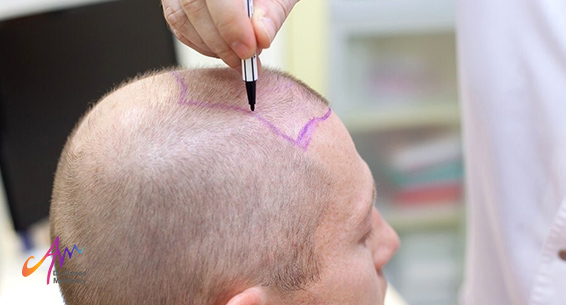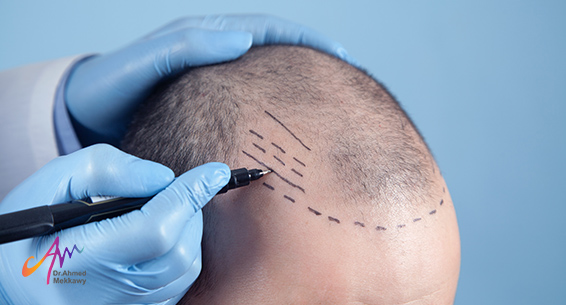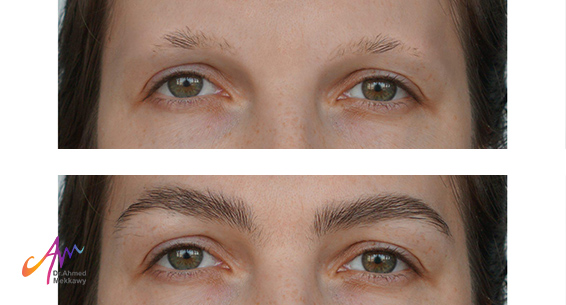Treatment for Alopecia

Treatment for Alopecia
Many people suffer from alopecia, which leads to a loss of self-confidence and various other issues. Here we explore the methods of treating alopecia, how to overcome it, and the most suitable and effective approach.
Causes of Alopecia:
Alopecia typically begins in the mid-twenties as hair loss occurs in scattered areas, especially at the front of the scalp. Over time, the rate of hair loss increases with age until complete baldness occurs in the thirties. The causes of alopecia include:
- The main cause is the inheritance of the baldness gene, as the genetic predisposition for baldness is already present in the family.
- The testosterone hormone is closely related to the baldness gene. This hormone stimulates the baldness genes, which weaken the hair follicles and cause them to shrink until the follicles die, resulting in baldness.
- Hair loss occurs gradually. It may start at the crown and spread to other parts of the head, receding the hairline until it disappears completely.
Other Causes of Baldness:
Other causes of baldness should also be recognized, such as:
- Certain diseases accompanied by hair loss may lead to baldness, such as autoimmune diseases.
- Stress and nervous tension negatively affect hair growth and cause sensitive hair follicles to shed.
- Taking medications containing hormones without consulting a surgeon can disrupt the body's hormonal balance, resulting in hair loss and baldness.
Treatment of Alopecia:
- First, it's essential to confirm that the person is suffering from genetic baldness, as many other issues could lead to baldness. Hair loss could be due to various reasons, not just genetic factors.
- Consultation with a surgeon is necessary if there is suspicion of alopecia, and the surgeon advises early intervention to address the problem.
- Taking necessary measures to reduce the progression of alopecia, such as undergoing plasma injection sessions and mesotherapy,
Treatment of Alopecia with Medications:
Some individuals turn to medications to treat or alleviate the effects of alopecia, such as:
Finasteride Medication:
This medication, identified in 1974, was used to treat prostate enlargement. However, it was observed to reduce hair loss. You should take the dose daily at a specified time and discontinue if side effects such as urinary flow issues, allergies to the medication's components, or stomach disorders occur.
Minoxidil Medication:
- Minoxidil is a topical treatment applied to the scalp to reduce hair loss, maintain existing hair, and promote hair growth.
- It is used for genetic baldness in women, early baldness in men, and conditions such as alopecia.
- However, this medication has side effects such as redness, skin irritation, and itching. You should take precautions, such as avoiding application near the mouth or eyes and ensuring thorough handwashing after use.
These medications provide a solution to genetic baldness, but the problem reoccurs once the medication is discontinued. Therefore, surgeons recommend more effective and permanent solutions.
Permanent Treatment for Alopecia with Hair Transplantation:
Hair transplantation is the best solution for alopecia, offering a permanent and long-lasting solution without significant side effects or risks. There are several techniques for hair transplantation, such as:
Follicular Unit Transplantation (FUT):
- In this procedure, the surgeon harvests a strip of the patient's scalp from the back of the head through a surgical incision. Then he divides the strip into smaller grafts and transplants them into areas of hair loss.
- This method saves time, effort, and money.
- There are minimal risks associated with this procedure, such as bruising and numbness, that subside over time with the help of pain relievers prescribed by the surgeon. However, it involves a surgical incision in the donor area.
- The final results of this procedure will appear within six to eight months.
Follicular Unit Extraction (FUE):
- In this procedure, individual hair follicles are extracted from various areas of the patient's scalp and then transplanted into areas with hair loss.
- This method is less painful than follicular unit transplantation, as it does not require a complete strip of scalp to be removed, leaving no scars or bruises.
- While this procedure takes longer as the surgeon extracts follicles, it yields the same results as follicular unit transplantation.
- The cost is higher than follicular unit transplantation, as it requires more time and effort.
- There are no significant side effects associated with this procedure, except for some minor bruising that fades over time.
- This procedure yields the same results as follicular unit transplantation.
Both techniques offer solutions for alopecia, providing natural-looking and long-lasting results. Consultation with a qualified surgeon, such as Dr. Ahmed Mekkawy, is crucial to determining the most suitable treatment approach based on individual circumstances.
Treatment of Alopecia with Injections:
When detecting alopecia early, the surgeon takes procedures to decrease the severity of this issue, including various injection techniques such as:
Platelet-Rich Plasma (PRP) Injection:
- PRP injection involves drawing a blood sample from the patient, extracting plasma through centrifugation, processing the plasma, and injecting it precisely into the scalp.
- PRP injections address hair loss and damage issues. They can also treat early baldness and reduce its severity.
- This method does not require surgical procedures, and results become noticeable after a few weeks.
- The side effects are minimal, with some redness and slight discomfort that subside over time. Patients can resume their normal activities immediately afterward, without any recovery period.
Mesotherapy Injection:
- Mesotherapy involves injecting the scalp with needles that contain nutrients. It promotes healthy hair growth and prevents hair loss without causing splitting or damage.
- This procedure has side effects, including sensitivity to the mesotherapy substance, redness, and bruises under the skin due to repeated injections.
- Mesotherapy is only suitable for cases of mild hair loss. Most surgeons do not recommend it for advanced baldness. However, it can be used after hair transplantation to stimulate better and healthier hair growth.
While most of these techniques and medications offer temporary solutions for alopecia, the most effective solution is hair transplantation. Hair transplantation is the only technique that provides a permanent solution for this problem, especially for advanced cases of alopecia.
If you are experiencing alopecia, take the necessary steps early to address the issue. Consult with a surgeon, follow his advice, and find the most suitable and appropriate solution for your condition. Do not delay if you notice early signs of alopecia; work on resolving the issue before it worsens. For more information about treating alopecia and the techniques used, you can consult with the best hair transplant surgeon in Egypt, Dr. Ahmed Mekkawy.
This content has been reviewed by Dr. Ahmed Mekkawy, a consultant in cosmetic surgery, body contouring, and natural hair transplantation.


.jpg)